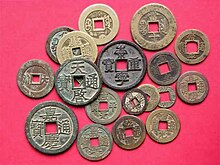Cash (Chinese coin)
| Cash | |||||||

Replicas of various ancient to 19th century cast cash coins in various metals found in China, Korea and Japan.
|
|||||||
| Traditional Chinese | 方孔錢 | ||||||
|---|---|---|---|---|---|---|---|
| Simplified Chinese | 方孔钱 | ||||||
| Literal meaning | square-holed money | ||||||
|
|||||||
| Alternative Chinese name | |||||||
| Traditional Chinese | 銅錢 or 銅幣 | ||||||
| Simplified Chinese | 铜钱 or 铜币 | ||||||
| Literal meaning | copper money or copper currency | ||||||
|
|||||||
| Transcriptions | |
|---|---|
| Standard Mandarin | |
| Hanyu Pinyin | fāng kǒng qián |
| Transcriptions | |
|---|---|
| Standard Mandarin | |
| Hanyu Pinyin | tóng qián or tóng bì |
Cash was a type of coin of China and East Asia from the 2nd century BC until the 20th century AD.
The English term "cash" referring to the coin was derived from the Tamil kāsu, a South Indian monetary unit. The English word "cash", meaning "tangible currency", is an older and unrelated word from Middle French caisse.
There are a variety of Chinese terms for cash coins, usually descriptive and most commonly including the character qian (Chinese: 錢; pinyin: qián) meaning "money." Confusingly, Chinese qián is also a weight-derived currency denomination in Chinese called mace in English.
Traditionally, Chinese cash coins were cast in copper, brass or iron. In the mid-19th century, the coins were made of 3 parts copper and 2 parts lead. Cast silver coins were periodically produced but are considerably rarer. Cast gold coins are also known to exist but are extremely rare.
Chinese cash coins originated from the barter of farming tools and agricultural surpluses. Around 1200 BC, smaller token spades, hoes, and knives began to be used to conduct smaller exchanges with the tokens later melted down to produce real farm implements. These tokens came to be used as media of exchange themselves and were known as spade money and knife money.
As standard circular coins were developed following the unification of China by Qin Shi Huang, the most common formation was the round-shaped copper coin with a square or circular hole in the center, the prototypical cash. The hole enabled the coins to be strung together to create higher denominations, as was frequently done due to the coin's low value. The number of coins in a string of cash (Chinese: 一貫錢; pinyin: yīguànqián) varied over time and place but was nominally 1000. A string of 1000 cash was supposed to be equal in value to one tael of pure silver. A string of cash was divided into ten sections of 100 cash each. Local custom allowed the person who put the string together to take a cash or a few from each hundred for his effort (one, two, three or even four in some places). Thus an ounce of silver could exchange for 970 in one city and 990 in the next. In some places in the North of China short of currency the custom counted one cash as two and fewer than 500 cash would be exchanged for an ounce of silver. A string of cash weighed over ten pounds and was generally carried over the shoulder. (See Hosea Morse's "Trade and Administration of the Chinese Empire" p. 130 ff.) Paper money equivalents known as flying cash sometimes showed pictures of the appropriate number of cash coins strung together.
...
Wikipedia
